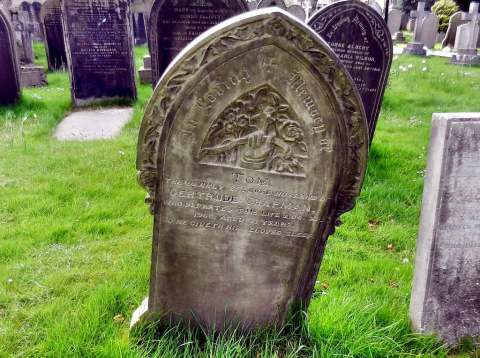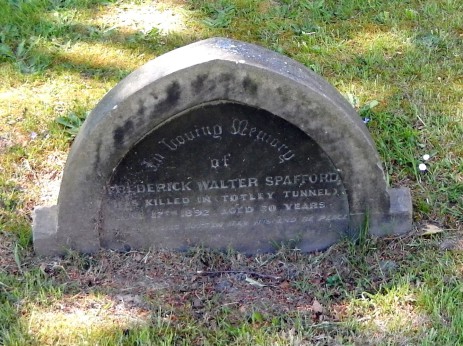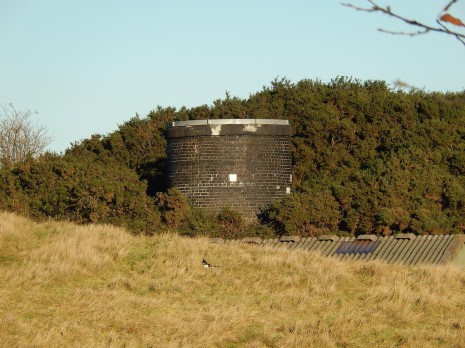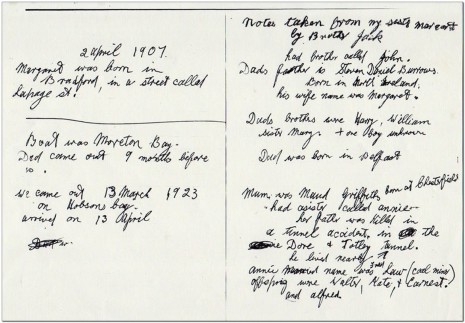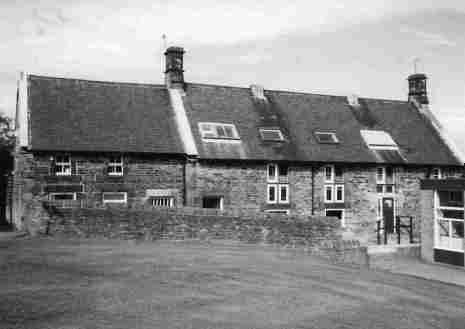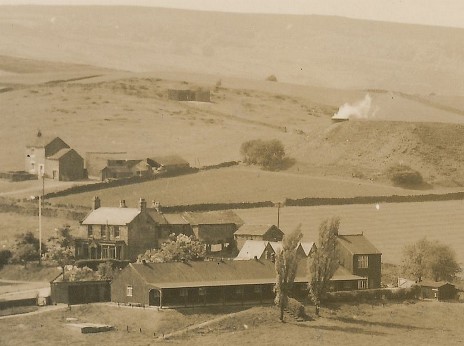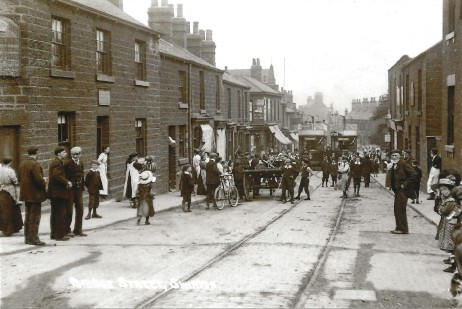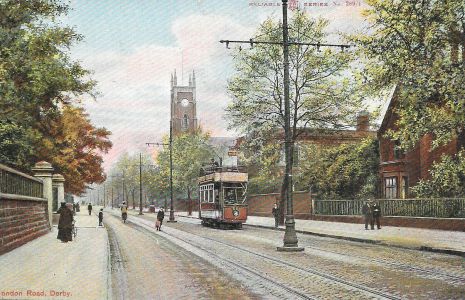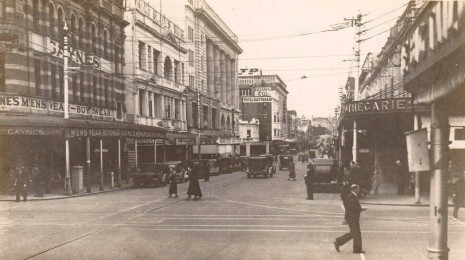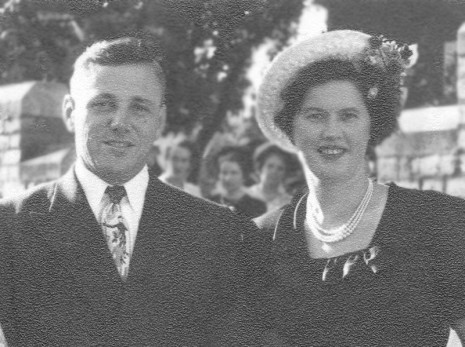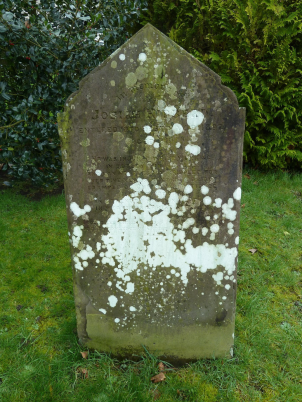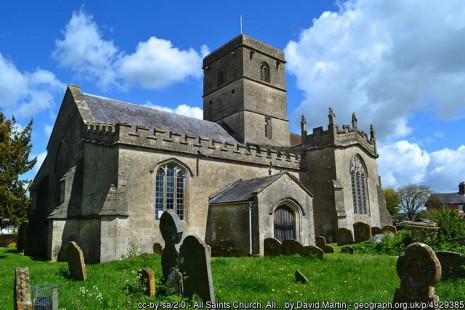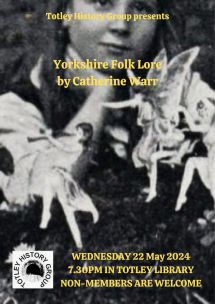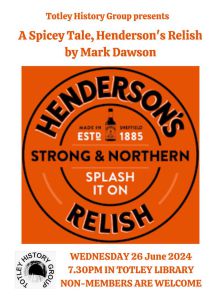Killed in Totley Tunnel
I thought you may be interested in the attached newspaper cutting which details the death of Thomas Chapman of Twentywell in a tragic incident in the Totley Tunnel.
Monday 3rd September 1906 The Sheffield Telegraph and Star (page 5)
Killed in Totley Tunnel: Platelayer's Terrible Injuries
An inquest has been held at the Crown Inn, Totley, by the Chesterfield Coroner, touching the death of Thomas Chapman (31), platelayer, of Twentywell, Totley. He had been married about seven months.
The evidence showed that Chapman was at work in Totley Tunnel on Thiursday, when an express from Sheffield to Manchester knocked him down, killing him instantly. The body was shockingly mangled.
"Accidental death" was the verdict.
Thomas, a platelayer with The Midland Railway Co, had married my 1st cousin 2x removed, Gertrude Slater, only seven months earlier and the couple lived at Twentywell,
probably Castle Row, where many of my brick maker ancestors lived. Gertrude never recovered fully from this tragic event, and died in 1934 at the Wadsley Lunatic Asylum. It was her
brother, Wilfred Slater, also a platelayer, who had the grisly job of recovering Thomas’s body from the Totley Tunnel.
Thomas Chapman is buried in Dore Churchyard. A photograph of his grave is to be found in your database of Dore gravestones.
Regards
Michael Hardy
Dronfield
February 2015
Frederick Walter Spafford
The writing on this small headstone in Dore churchyard is only visible when the grass has been recently cut. It reads:
In Loving Memory/of/FREDERICK WALTER SPAFFORD,/WAS KILLED IN (TOTLEY TUNNEL)/JUNE 17TH 1892. AGED 30 YEARS/HIS DEATH WAS SUDDEN MAY HIS END BE PEACE/
There is no mention of Frederick in Brian Edwards's book Totley and the Tunnel (1985, reprinted November 1989), so we thought we would try to find out who he was and how he came to die.
Frederick Walter Spafford was born on 1 January 1862 in Lincoln, the son of William Spafford, a wheelwright and threshing machine maker from Beckingham, Lincolnshire and his second wife Ann (nee Whyley).
William Spafford had six children with his first wife, Anne Swain: Arthur (born 1848), Alfred (1850), Selina (1852), Emily (1855), Horace (1857) and William Swain, born in 1859, the same year as his mother died, quite possibly in childbirth. William Spafford married again in 1860 and had five more children: Walter (born in 1860), Frederick Walter (1862), George Andrew (1863), Mary Alice (1865) and Bernard (1876). Walter and George Andrew died in infancy.
The Spafford family had moved to Newport, Shropshire by 1865 and in the 1871 Census Frederick is shown as a scholar living in Old Workhouse Lane, Newport with his parents, Selina, Horace, William Swain and Mary Alice. The family had returned to Lincolnshire by 1877 because on 8 July Frederick was baptized at Bracebridge, just south of Lincoln, along with his younger siblings Mary Alice and Bernard. In the 1881 Census, Frederick, Mary Alice, Bernard and their parents were living at Newark Road, Bracebridge and Frederick was shown as a general labourer. He seems to be missing from the 1891 Census and when he came to Totley is not known. He was living at the navvy huts on Totley Moor at the time of his accident.
Frederick died on 17 June 1892, four months before the tunnel finally pierced through Totley Moor. The Sheffield Independent reported his death and the inquest which followed.
Monday 20th June 1892 Sheffield Independent (page 7)
Shocking Death At Totley Tunnel
A fatal accident occurred on Friday morning in the tunnel in course of construction on the Dore and Chinley Railway at Totley. A miners' labourer named Frederick Walter
Spafford, of Lincoln, was engaged with another man taking down the centres on which the arch of the tunnel is built, when, without any warning, one of the heavy ribs fell over, striking the deceased
on the back of the head, smashing in the skull and jamming the poor fellow against a heavy cross beam, where he hung suspended by the head until liberated by a number of men who were summoned to
extricate him. He was removed to the surface as soon as possible, but expired in a very short time. The body was removed to the Cricketers' Arms, Totley Bents.
Wednesday, 22nd June 1892 Sheffield Independent (page 5)
Fatal Accident At Totley
An inquest was held yesterday at the Cricket Inn, Totley Bents, concerning the death of Frederick Walter Spafford. - Verdict, "Accidentally killed by a rib accidentally
falling on the deceased's head whilst following his employment in the tunnel on the Dore and Chinley Railway."
Frederick was buried at Dore Christ Church on 20 June 1892.
George Griffiths, Totley Tunneller
When Jack Burrows died in Perth, Western Australia last year at the fine old age of 100 years, a scrap of paper found in his belongings led to his long time neighbour, friend and administrator, Trevor Lawton contacting Totley History Group to try to obtain some information about Jack's family history.
Trevor is no stranger to family history himself having been a member of Saddleworth Historical Society many years ago. That scrap of paper in Jack's own handwriting gave his mother's maiden name as Maud Griffiths and said that her father had been "killed in a tunnel accident in Dore and Totley tunnel". There is no mention of an accident to a miner called Griffiths in Brian Edwards's book Totley and the Tunnel but from online newspaper archives and genealogy databases in England, Scotland and Ireland, we have been able to put together the story behind Jack's note.
On Monday, 18 February 1889 an evening of entertainment took place in the school room, Totley under the patronage of William Aldam Milner of Totley Hall and Joshua Tyzack of Beauchief in aid of the widow and children of the late George Griffiths, a miner who had been killed in the construction of the Totley Tunnel on 13 December the previous year. Nearly three hundred people paid for admission, a large number of whom were navvies and their wives and others who had come from Dore, Beauchief, Norton, Bradway, and Holmesfield.
Rev. J. T. F. Aldred, vicar of Dore, was chairman and at the opening of the entertainment he welcomed the navvies to Totley and said that the school room would be placed at their disposal any time they would like to put on their own entertainment. The programme commenced with a magic lantern show and was followed by an evening of music and song, featuring amongst others The Dore and Totley Christy Minstrels. At the close of the programme, William Milner proposed a very hearty vote of thanks to all those who had come forward to assist in making the evening a success. Thomas Oxenham seconded the vote of thanks on behalf of the navvies on the Dore and Chinley Railway.
George Griffiths died following an explosion during the sinking of number 3 airshaft at Totley Bents. George was one of two men whose job it was to prepare and set the charges in a series of six holes about an inch and a half in diameter and two and a half feet deep bored in the rock. Each charge was made up of a cartridge of gelignite and a primer, a part cartridge into which was embedded a detonator to which was attached a fuse. When all six charges were in place, the holes were filled with water and sealed with clay and the fuses lit by means of a candle. The shaft was already between 120 and 150 feet deep and the fuses were sufficient to give the men between three and four minutes to be drawn up to the surface and to retire to safety. Three successful blastings had taken place in the morning.
In the afternoon, James Bembridge was getting the candles ready whilst George was setting the charges. He put cartridges in two of the holes which dropped to the bottom but the third one got stuck in the hole. As was the usual practice, he stood up to press the cartridge down with a long stick when there was an explosion. A team of men was sent down the shaft and both injured miners were speedily brought to the surface and medical attention summoned but George died about an hour later. He had been struck on the forehead by the full force of the flying rock as well as suffering a broken right arm and injuries to his left leg. Although standing only a yard and a half away, James suffered very minor cuts and bruises.
The inquest opened at the Cricket Inn on 15 September for identification purposes only and was continued at the Crown Inn on 20 December when Major Cundall, one of H.M. Inspectors of explosives was present. It was concluded that the explosion occurred when George was attempting to force a second piece of gelignite side by side with a first piece which had become stuck fast in the hole. The inspector explained that whilst gelignite is malleable under normal temperatures, it becomes quite hard when cold. It was likely that the cartridge had become affected by frost, making it much more sensitive to explosion. A verdict of "Accidental Death" was returned.
George Griffiths was aged 35 and lived in Chapel Street, Whittington, Derbyshire. He was buried on 17 December 1888 at St. John the Evangelist, Newbold. Little has been found out about the man himself. According to his brother James, who was in charge of the airshaft at the time of the accident, George was an experienced miner who had worked in many places across Yorkshire and had been used to similar explosives for about twelve years. George had married Florence Woodward in 1885 at Chesterfield Register Office. Florence was born on 31 August 1861 in Chesterfield, the first of seven children of John Woodward, a furnace labourer, and his wife Ann Hall, who married on 4 March 1861 in North Wingfield, Derbyshire. George and Florence had two daughters: Maud, born on 16 October 1885 in Newbold; and Annie, born on 5 November 1887 in Whittington.
The year after George was killed, Florence remarried to Frederick Hall at St. Bartholomew, Whittington on 5 August. Frederick was a bachelor and a furnace labourer by trade who was born about 1862 in Derby. The family continued to live in Chapel Street, Whittington and Maud and Annie attended the Whittington Moor Junior School. Sadly, their mother died on 16 October 1892 at the age of 31 and was buried at Newbold three days later. By April 1896 Frederick, Maud and Annie were living at Court 4, House 8, Walker Lane, Derby. Maud and Annie attended the Orchard Street School.
What became of Frederick Hall we do not know but by the time of next census on 31 March 1901, Maud and Annie were living in Swinton, near Mexborough, having been adopted separately. Maud, aged 15, was the adopted daughter of Susannah and Arthur Earl, a coal miner, of 82 Queen Street. Annie, aged 13, was the adopted daughter of Alice and Charles Oliver, a greengrocer, of 24 Albert Street.
Annie Griffiths lived in Swinton for the rest of her life. She gave her address as the Don Hotel, on Bridge Street, when she married Fred Law, a coal miner, at St. Margaret's Church on 3 June 1908. Fred was born about 1880 in Swinton, the son of Alfred Law, a labourer. Annie and Fred lived at 28 Fitzwilliam Street where they had five children; Mary Kate born on 12 December 1908, Walter born 28 September 1910, Ernest born 5 April 1918, Alfred born on 15 December 1924 and Betsy born about 1931.
As if the mining accident which killed her father were not enough, a second mining accident was to result in the death of Annie's husband. Fred Law was working at the Manvers Main Colliery on 4 April 1932 when he suffered a head injury which resulted in a loss of sight in the left eye and severe pain. During the early hours of 14 April he rose from his bed and left the house. When he didn't return, Annie, together with her son Walter and son-in-law went to search for him but found only his hat and coat on the side of the canal, close to Green Lane Bridge. They went to fetch the police and searched for a while but finding nothing they abandoned their search until daybreak. The next morning, the police began dragging the canal and found Fred's body.
An open verdict of "Found Drowned" was returned by the coroner who added that there was no evidence to show how the deceased got into the water. At Doncaster County Court, on 31 October 1932, Annie Law was awarded compensation of £600 against Manvers Main Collieries Limited for the death of her husband. After considering all the medical evidence, the colliery company agreed that Fred had taken his own life whilst temporarily insane as a direct result of the injuries he had suffered in the pit. Annie never remarried and died in Montague Hospital, Mexborough in November 1946 at the age of 59.
Maud Griffiths was living at Liversage Street, Derby when she married John Burrows, an iron moulder, on 4 June 1906 at Holy Trinity Church, London Road. At the time of his marriage John was living in Bradford, Yorkshire but he had been born in Belfast, Northern Ireland around 1879, the second of six children of Stephen Burrows, an iron moulder, and his wife Margaret Greenlaw who had married on 31 December 1875 in Maryhill, Lanarkshire. Maud and John made their home in Lapage Street, Bradford where their first child, Margaret, was born on 2 April 1907. Their second child, John Burrows junior, known as Jack, was not born until 3 February 1920 when the family were living in Rhyl, Flintshire.
In 1922 John Burrows accepted a job offer from the Forwood Down Engineering Company in Western Australia and the family emigrated to Perth. John embarked aboard the Commonwealth Government Line steamship Moreton Bay at the Port of London on 29 August 1922 bound for Freemantle. The following year, Maud, Margaret and Jack followed aboard the Hobson's Bay which left London on 13 March and arrived at Freemantle on 13 April 1923.
For many years the Burrows family lived at 626 Murray Street and later at 149 Cambridge Street in the Leederville district. Jack went to the Thomas Street State School and later Perth Boys School in James Street. His father arranged an apprenticeship at Forwood Downs where he became a fitter and turner. By the time of the Second World War, Jack's engineering skills meant that he was exempt from military service. He was sent to Hendon in South Australia to learn the manufacture of .303 ammunition. He returned to work at a munitions factory that was built at Adams Drive in Welshpool, a southeastern suburb of Perth. The factory expanded to include the manufacture of igniters for the Bofors 40mm anti-aircraft guns.
During this time Jack met his future wife, Mary Henderson Boyack Ritchie, who also worked at the factories in Hendon and Welshpool. Mary had been born in Grants Place, Kennoway Road, Windygates, Fife on 21 September 1917, the daughter of William Ritchie, a coal miner, and his wife Agnes Boyack who married on 31 December 1910 in Dundee. The Ritchies had emigrated to Western Australia aboard the Hobson's Bay in January 1927. Jack and Mary married in 1944. They had no children but enjoyed 71 years of marriage before Mary died on 28 July 2015 aged 97. Jack Burrows, grandson of Totley tunneller George Griffiths, died on 20 November 2020.
We wish to thank Trevor Lawton for his help in writing this article.
January 2021
Josiah Hibberd
Peter Griffin got in touch with us from All Cannings, near Devizes in Wiltshire. In the graveyard of All Saints Church is a headstone which bears an inscription telling how Josiah Hibberd was seriously injured whilst working on the construction of the Totley Tunnel in 1892. The inscription provides no information about Josiah's birth or his family and Peter was curious to know if we could throw some light on Josiah's life and how he came to be injured.
The inscription reads:
In memory of
JOSIAH HIBBERD
ENTERED INTO REST MAY 9 1897,
AGED 38.
HE WAS INJURED WHILE WORKING
IN TOTLEY TUNNEL, 1892,
AND LAY HELPLESSLY CRIPPLED FOR
OVER FIVE YEARS SETTING A BRIGHT
EXAMPLE OF CHRISTIAN PATIENCE
TILL GOD TOOK HIM.
IN STRENGTH HE FOUND CHRIST,
IN WEAKNESS CHRIST KEPT HIM.
I COUNT ALL THINGS BUT LOSS FOR THE EXCELLENCY
OF THE KNOWLEDGE OF CHRIST JESUS MY LORD.
The last two lines are taken from Philippians 3:8 (King James Version).
There is no mention of Josiah Hibberd in Brian Edwards's book Totley and the Tunnel nor in Ted Hancock's new book The Hope Valley Line, Vol I. A newspaper search has yielded no mention of Josiah's accident. As we have noted before, deaths and subsequent inquests were invariably reported in the Sheffield and North Derbyshire press, but non-fatal accidents were often not reported at all or, in many cases, the injured men were not named.
Our research into who Josiah Hibberd was met with greater success. He was born in 1858 in All Cannings and baptised at All Saints Church on 7 August 1858. His father was George Hibberd, an agricultural labourer who was born in nearby Stanton St. Bernard and baptised there on 18 May 1823, the son of Thomas Hibberd, a labourer, and Elizabeth Fowle who married on 6 December 1821 at Stanton St. Bernard. Josiah's mother was Eliza Ellis who was born in Allington (in All Cannings Parish) and baptised at All Saints Church on 14 June 1818, the daughter of William Ellis, a labourer, and Jane Chick who had married at the same church on 3 April 1805.
Josiah's parents married at All Cannings on 28 November 1846. They had six children that survived to adulthood, all of whom were baptised at All Cannings: Jane on 6 February 1848, Ruth on 3 February 1850, Susan(na) on 1 February 1852, Thomas on 6 August 1854, Josiah on 7 August 1858 and Ellen on 7 July 1861. Another Ellen, who was baptised on 3 August 1856, died at the age of 9 months and was buried in the Churchyard on 1 May 1857. In the 1851 and 1861 censuses the Hibberd Family were shown as living on The Street, All Cannings.
By 1871 the Hibberds' three eldest daughters had left home. Jane had married George Rose Hiscox on 16 April 1868 at All Cannings. Ruth and Susan were domestic servants in the household of John Deverell, a baker, of 68 New Park Street, Devizes. Whilst Ruth would still be there ten years later, Susan married Mark Knee, a labourer, on 26 May 1877 at the Parish Church, Southbroom and was living in Devizes.
That left just Thomas, Josiah and Ellen at home with their parents when the 1881 census was taken. Thomas had become a horsekeeper and was recorded as being married although with no wife or children. We have been unable to find a marriage or trace what became of him. Josiah was a bricklayer's labourer and Ellen was an agricultural labourer. Elizabeth Hibberd died in 1883 aged about 64 and after Ellen's marriage to William Ponting, at All Cannings on 20 July 1889, George Hibberd went to live with his daughter and son-in-law. Josiah might have left All Cannings at about the same time.
In the 1891 Census Josiah was in lodgings at 36 Aldred Street in Eccles, Lancashire. He was still single and was recorded as a general labourer. Like many in that town, he may have been working on the construction of the nearby Manchester Ship Canal which at that time also included dam building and diversion of rivers and railway lines. There was plenty of work for bricklayers and their labourers. Work on the canal had begun in 1887 and continued until 1894, the dates overlapping those of the construction of the Totley Tunnel. We know from other examples we have looked at that some of the tunnel navvies had earlier worked on the ship canal. They were usually to be found working from the western portal at Padley rather than at the eastern Totley end of the tunnel.
For Josiah to be injured in 1892, he could have only been in our area for a matter of a year or so. We have been unable to find any further mention of him, except perhaps, for one item in the Wiltshire Times and Trowbridge Advertiser for 9 February 1895. Mr Baldwyn Fleming presented a report to the Devizes Board of Guardians about issues arising from his visit to the Devizes Workhouse. Mr. Fleming said:
Josiah Hibberd, in the male Infirmary, asked me if there was any rule that letters written by him should not be sent daily. He was only allowed to send out letters once a week. This seems to me to be an unreasonable restriction. I can see no reason why letters should be detained after they are written. Hibberd also stated that he thought it hard that when people came from considerable distances to see him on visiting days there should be a rule that they should only stay 20 minutes. The Matron told me there was such a rule, but frequently it was not insisted upon. I think, however, that the rule is not a satisfactory one. Subject, of course, to the directions of the Medical Officer and the nurses, in any particular case, it is desirable that visitors should have every reasonable facility for seeing their friends, so far as is consistent with the maintenance of proper discipline and order in the wards. Hibberd did not complain, but only asked that these rules might be revised. He said he was grateful for the kind treatment he received.
It seems most likely that this newspaper report refers to Josiah Hibberd, the Totley tunneller. He appears to have been in hospital for some time and with the prospect of a further lengthy stay to which he was fully resigned. This seems to be consistent with the inscription on the gravestone. There were only five other men named Josiah Hibberd in all of England at this time and only one in Wiltshire and he was living at Steeple Langford, well outside the Devises Poor Law Union.
Sadly, there is no newspaper report of Josiah's death, not even a family announcement, but by then his father had also died.
March 2021
Search Our Website Here
Future Meetings
April
May
June
Unless stated otherwise our meetings are held in Totley Library on the 4th Wednesday of each month at 7.30pm.
Pauline Burnett's book The Rise of Totley Rise has been revised and updated. It tells the story of this small piece of land from 1875 when there was only a rolling mill and chemical yard alongside the river a mile from Totley, through Victorian and Edwardian times, two world wars and up to the present day. It has 94 pages including a useful index and many illustrations from private collections. The book is available now from Totley Rise Post Office priced at £5, or through our website when an additional charge will be made to cover packing and postage.
A few copies are still available of Sally Goldsmith's book Thirteen Acres: John Ruskin and the Totley Communists. Totley was the site of a utopian scheme funded by art critic and social reformer John Ruskin. In 1877 he bought 13-acre St. George’s Farm so that nine Sheffield working men and their families could work the land and, to keep themselves busy, make boots and shoes. Sally tells an engaging story from our history with a quirky cast of characters including Ruskin himself, the poet and gay rights activist Edward Carpenter and Henry Swan, a cycling, vegetarian artist and Quaker. The book is available to order online from the The Guild of St. George by following this link.
A recently discovered box of WWII correspondence reveals the story of how a small group of ladies from Dore and Totley recruited knitters from the west of Sheffield and how their efforts made them the country's greatest provider of Comforts for the Minesweeping crews of the Royal Navy. The story is told in Knit For Victory, a new book from Totley History Group. Written by Pauline Burnett, it has 82 pages and many illustrations. It is on sale in local shops and via our website. Further information about the correspondence is in this inside page of our website: Dore & Totley Minesweeping Trawlers Comforts Fund.
The story is told in Totley War Memorial WW1 of the ten men from our village who gave their lives in the Great War. Written by Pauline Burnett, Jim Martin and Dorothy Prosser, a chapter is devoted to each of the soldiers with a family tree followed by as much information as could be discovered about the men and their families. There is also information about their military careers and the actions in which they lost their lives. The book has 64 pages and is illustrated throughout with photographs of the men, their families and the houses where they lived.
Totley All Saints' Church Parish Magazines for the years 1985-2006 with notices of baptisms, marriages and funerals and accounts of spiritual, educational, charitable and social matters in the village. Scanned in full, including advertisements from local traders.
In 1893 during the building of the Totley Tunnel there was an outbreak of smallpox amongst the navvies which spread to some of the local population. 17 people were buried in communal graves in Dore Churchyard, 6 from "Green Oak" (Lemont Road). The severity of the outbreak was principally caused by overcrowding and insanitary conditions in lodging houses .
Kathleen Grayson was a 39 year old housewife when WW2 broke out. She volunteered for the ARP and became an ambulance driver. During an air raid on Sheffield in July 1941, and despite her own injuries, she managed to get a seriously injured casualty to hospital. For this she was awarded a commendation from King George VI. Together with her friend Hilda Duffy, Kathleen also assembled a team of knitters to provide essential warm clothing for the men serving on the minesweepers patrolling the North Sea.
We have recently bought at auction the WW2 memorabilia of Douglas Platts whose family home was at Hillside, 98 Queen Victoria Road. After the war Douglas returned to his civilian occupation working in the family scissors manufacturing business. He lived in our area for the rest of his life.
We are very grateful to Mrs Valerie Taylor of Dore for lending us the title deeds to Lower Bents Farmhouse which is reputed to be the oldest surviving building in the area with a proven history back to 1621. We have now scanned and transcribed the deeds which could be particularly interesting to anyone with a connection to the local Fisher, Dalton and Marshall Families.
Until 1844, when Dore Christ Church parish was created, Totley township was part of Dronfield parish. We have now transcribed the burial records for former Totley residents at St. John the Baptist, Dronfield for the period 1678-1870 and at St. Swithin, Holmesfield for the period 1766-1901.
Whilst researching the history of the Dalton Family we found it useful to transcribe a number of early Wills and Inventories. These and those of many other Totley, Dore and Holmesfield people dating from between 1594 and 1856 have now been added to our website.
St. Swithin's Church, Holmesfield pre-dates Dore Christ Church and was the place where many of the people from Totley worshipped and were baptised, married and buried. Read the inscriptions on more than 750 gravestones in the churchyard including those of Mr. and Mrs. William Aldam Milner of Totley Hall, Jessie Matilda Tyzack (nee Fisher) of Avenue Farm, and Rev. J. A. Kerfoot of St. John's, Abbeydale.
Thomas Youdan was a music hall proprietor and benefactor who was living at Grove House, Totley in 1867 when he sponsored the first football knockout competition in the world for The Youdan Cup.
The words Millhouses Cricket Club can be seen in the background of team photos which are likely to date from between 1905 and the early 1920s, very probably pre-war. They were lent to us by Garth Inman who can identify his great uncle, Cecil Inman, in some of the photos and would like to know when they were taken and, if possible, the names of others present. Please take a look to see whether you can put names to any of the faces.
Josiah Hibberd was seriously injured whilst working on the construction of the Totley Tunnel in 1892. He died on 9 May 1897 at the age of 38 having apparently spent most of previous five years in hospital.
Bradway House was built around 1832 by Henry Greaves, a farmer, together with two adjacent cottages. We have traced most of the occupants of the property from these early days up to the start of World War Two.
We have transcribed the baptisms records at St. John the Evangelist, Abbeydale from when the church was consecrated in 1876 until just after the start of World War 1. The records are arranged in alphabetical order based upon the child's name and show the date of baptism, the names of the parents, their home location and occupation.
Nick Kuhn bought an original 1920s poster which had this owners' blind stamp in one corner. The stamp almost certainly refers to a house named Wigmore that was built in the late 1920s or early 1930s. The first occupiers that we can trace are John Howarth Caine, a district mineral agent for the LNER, his wife Florence Jane (nee Prince) and daughter Doris Mary. The Caine family lived at Wigmore until 1936 by which time the house would have been known simply as 12 The Quandrant.
George Griffiths died on 13 December 1888 following an explosion during the sinking of number 3 airshaft at Totley Bents. His widow Florence died shortly afterwards and his two daughters Maud and Annie were adopted separately. Whilst Annie lived the rest of her life in Yorkshire, Maud emigrated to Australia in 1923 with her husband, John Burrows, daughter Margaret and son Jack, pictured above.
George Wainwright was said to have been born in Bamford, Derbyshire in 1714. He learned the trade of linen weaving and moved to Totley after his marriage on 1744. He became an ardent follower of John Wesley who paid many visits to Sheffield and who would have passed through or close to Totley. Preaching was at first conducted out of doors and when Wesley's preachers became harassed by a mob of Totley ruffians in 1760, George offered them safety of his own home. He remained a Methodist for all of his long life, dying in Dore in 1821 at the reputed age of 107.
Oakwood School was started by Mrs Phoebe Holroyd in 1925 initially as the Firth Park Kindergarten and, by 1927, as the Firth Park Preparatory School. Phoebe was still working at the school almost fifty years later when she was well into her seventies. We would like to hear from anyone with memories of the school.
James Curtis was born at sea aboard HMS Chichester in 1790. He enlisted as a Private in the 1st Grenadier Regiment of Foot Guards in Sheffield in 1812 and served in Spain and Portugal during the Peninsular War. He later fought in France and Belgium taking part in the Battle of Waterloo. In later life James lived at the Cricket Inn where his son-in-law William Anthony was the licensed victualler. He died in Heeley in 1882 aged about 91.
Charles Paul lived in Totley in later life. He was a local historian and archaeologist who was an authority on the history of Sheffield, especially the two areas he knew best: Attercliffe and Ecclesall. His books and letters to local newspapers were published under the Latin form of his name Carolus Paulus.
Towards the end of the 19th century Totley Hall gardens became a well known beauty spot that attracted many hundreds of visitors from Sheffield on open days and the rock gardens became one of its most popular features. Mrs Annie Charlesworth sent us six glass transparencies of the rock gardens taken, we believe, in the early years following the Great War.
Anton Rodgers send us photographs of three water-colours that had been bought by his grandfather at a sale of the contents of Abbeydale Hall in 1919. One was of a scene said to be in York by A. Wilson. A second was of a seated child with a dog believed to be pianted by Juliana Russell (1841-1898). The third was of Lake Como, by Ainslie Hodson Bean (1851-1918) who lived for much of his life on the Riviera and in North Italy.
A Canadian correspondent sent us photographs of a set of silver spoons that were bought in a small town in British Columbia. The case contained a note signed by Ebenezer Hall indicating that they were a wedding gift to Maurice and Fanny Housley. We think we may have traced how they got to Canada and where they might have been since.
Green Oak Park was opened on 23 March 1929 on land that had been bought by Norton District Council from John Thomas Carr, a farmer and smallholder of Mona Villas. In later years, the buildings were used by the Bowling Club (the green having been built in 1956) and by the park keeper. However, the buildings appear to have been constructed in several phases, the oldest of which predates the park to the time when the land was used for pasture.
We believe the old Totley Police Station at 331 Baslow Road was built around 1882. Two lock-up cells were excavated just below floor level in the summer of 1890. We have traced the Derbyshire Constabulary police officers who lived there from John Burford in 1886 to George Thomas Wood who was there when Totley was absorbed into Sheffield in 1934.
David Stanley lived in Totley Rise in the later years of his life. Born in Bulwell, Nottinghamshire, he joined the 17th Lancers when he was 19 and rode in the Charge of The Light Brigade at the Battle of Balaclava where he was seriously wounded. For the first reunion of veterans in 1875, he told his story to a reporter from the Buxton Herald.
This picture postcard was addressed to Miss Abell, Holly Dene, Totley Brook Road and posted in Rotherham on 10 December 1907. Edith Annie Abell was born on 4 February 1887 in Sheffield and her family came to live in our area in the 1900s, staying for the rest of their lives.
Charles Herbert Nunn enlisted in the British Army on 23 August 1915 and was sent to France on 18 December 1915 to served with the British Expeditionary Force. In March 1916 it was discovered that he was underage and he was returned home. Shortly after his 18th birthday he re-enlisted and was again posted abroad where, in addition to this trio of medals, he was awarded the Military Medal.
This certificate was awarded jointly by the Red Cross and St. John's Ambulance to Isaac Henry Williams, of Lemont Road, for his services during WW1 as a stretcher bearer. We are seeking anyone who can help us pass it on to a living relative.
In 1832 Samuel Dean pleaded guilty to stealing a quantity of lead from the Totley Rolling Mill and was sentenced to seven years transportation to Australia. He sailed on the Mangles and upon arrival in New South Wales he was sent to work for William Cox, the famous English explorer and pioneer. After receiving his Certificate of Freedom in 1840, Samuel became a farmer and went on to have a very large family. Samuel was born in Whitechapel around 1811 to parents Samuel Dean Snr. and Susannah Duck. His descendant Sarah Dean would like help in tracing his ancestry.
Ellen Topham was born in 1889 in Nottingham. Her parents had been living together since 1862 but had never married so it was most unusual that, after their deaths, Ellen was accepted into Cherrytree Orphanage. Even more so since her father, Snowden Topham, had been acquitted somewhat unexpectedly in a widely reported manslaughter trial. Ellen remained at Cherrytree until her death from pulmonary tuberculosis at the age of 15.
Mabel Wilkes was a resident in Cherrytree Orphanage between 1897 and 1905. Her granddaughter Sally Knights sent us these images of a book presented to Mabel as a prize for her writing. Sally also sent us some personal memories of her grandmother and a photograph of a locket which contains portraits of Mabel and her husband Septimus Gale.
John Henry Manby Keighley was living at Avenue Farm when he enlisted in 1916. He fought in France with the Cheshire Regiment but after home leave in early 1918 he went missing. The Army were unable to determine whether he had deserted or returned to the front and been either killed or captured by the enemy. In August 1919 he was formally presumed killed in action but it appears he did not die but returned home to his family.
Horace Ford was admitted to Cherrytree Orphanage on 26 October 1888 at the age of six. He left at the age of 14 to become an apprentice blacksmith and farrier. Soon after his 18th birthday Horace enlisted in the Imperial Yeomanry to serve his country in the war in South Africa. His letter home to his Orphanage mentor tells of the lucky escape he had in battle.
Pat Skidmore (née Sampy) lived on Totley Brook Road from 1932 to 1948 before her family moved to Main Avenue. In this short article she remembers her time at Totley All Saints School where she was a contemporary of Eric Renshaw and Bob Carr.
As we have nowhere to exhibit memorabilia and artifacts, we have created a Virtual Museum instead. The latest addition to our collection is this double-sided Totley Rise Post Office oval illuminated sign which was on the wall of 67 Baslow Road before the Post Office business transferred to number 71. Please contact us by email if you have things that you own and would like to see added to the virtual museum.
Conway Plumbe was a man of many talents who came to live in Totley Rise around 1912. As a young man he had poems published by Punch magazine and is remembered in modern collections of WW1 poetry. A number of his paintings were accepted by the Royal Academy. An engineering graduate of London University, he joined the Civil Service where he rose to a high level as a factory inspector, publishing two books on the subject and giving a series of talks on workplace health and safety on BBC radio during WW2. In retirement he wrote a philosophical-spiritual work called Release From Time.
Inside Totley Rise Methodist Church there is a Roll of Honour commemorating the soldiers from its congregation who served their king and country during the Great War. For all but one of the 28 names the soldier's regiment is recorded in the next column. The exception is David Cockshott for whom 'killed in action' is written alongside yet he appears on no war memorial in our area and no record of a mortally wounded soldier of that name is to be found. We think we have solved the mystery.
Mrs. Kate Plumbe moved from Mansfield to Totley Rise with a number of her family in 1913 and became closely involved with the Totley Union Church. Her daughter Winifred became a missionary and headmistress in Calcutta for over 38 years following which she returned home to live with her sister Hilda on Furniss Avenue. Hilda had also been a teacher, missionary and, like her mother, a volunteer at St. John's VAD during WW1.
Thomas Glossop was a cutler and razor manufacturer who was well known amongst cricketing and gardening circles. Despite going blind, he was able to continue his hobbies with remarkable success
The Totley Union Cycling Society Prize Giving and Fete was held on the fields near Abbeydale Hall on 18 July 1914. Anne Rafferty and Gordon Wainwright have named some of the people in two wonderful photographs of the event. Can you identify any more for us?
The Tyzack family are well known in our area for owning iron and steel trades at Walk Mill, Abbeydale Works, Totley Rolling Mill and Totley Forge. This article covers the history of the family from the late 18th century when William Tyzack the founder of the company was born until the early 20th century when Joshua Tyzack farmed at Avenue Farm, Dore.
Walter Waller Marrison moved to Totley around 1897 with his wife and their two young sons. He was a house builder who constructed properties around Totley Brook and Greenoak before ill health forced him to take up less physically demanding work. In 1904 he took over the tenancy of the grocers and off licence at number 71 Baslow Road. After his death in 1908, his widow Kate and later their eldest son Jack continued to run the business until it was sold in 1934.
Ron Wijk of Nieuw-Vennep in the Netherlands has sent us two scanned images of drawings of old cottages made by the celebrated Dutch painter, Anton Pieck (1895-1987) simply annotated "Totley", and wondered whether we could identify their locations.
We would like to thank Christopher Rodgers for bringing to our attention this fascinating log of the 85th Sheffield (St. John's and Totley Orphanage) Wolf Cub Pack for 1927-45. The log is published jointly by Sheffield Scout Archives and Totley History Group as a free PDF download. It is illustrated by no fewer than 92 photographs and is supported by a comprehensive index and biographies of some of the main participants.
Following our Open Meeting event on School Days, Roger Hart, Howard Adams and John Timperley have each written to us with their memories of Norwood School, which was located in the rooms attached to the Dore & Totley United Reformed Church on Totley Brook Road.
On 22nd July 1909 the children of Dore and Totley Schools celebrated by a pageant the union of England under King Ecgbert which took place at Dore in AD 827. The pageant was devised and written by Mrs Sarah Milner and her daughter Marjorie and performed in a field close to Avenue Farm in front of a large audience. Photographs of the event survive together with a fragment of the script.
John Edward Greenwood Pinder had lived all 46 years of his life in Totley but on census night, Sunday 2 April 1911, he was not at home; he was in Derby Gaol serving a sentence of three months hard labour. From the age of 20, John had been in and out of local courts for a series of minor offences including drunkenness, assault, wilful damage and night poaching. Finally he was sent to gaol for cutting down and stealing 86 small trees which he sold in Sheffield market for Christmas.
We have already transcribed the census returns for Totley, Totley Rise and Dore. Now we have transcribed Census Strays. These are people who were born in Totley but are missing from our earlier transcriptions. They may have been living, working or studying elsewhere or just away from home on the night the census was taken. Two people were in prison. Others were in Union Workhouses, hospitals and asylums. Fully indexed strays from the 1851, 1861, 1881, 1891, 1901 and 1911 censuses are available now.
We wish to thank Gillian Walker for allowing us to digitize an archive of material about the 1st Totley Scout Group. Most of the material was collected by Arthur Percival Birley in the period 1949-51 and there are many interesting documents pertaining to the building of the scout hut on Totley Hall Lane. In addition four Newsletters survive, two from the 1940s and two from 1971.
We are grateful to Angela Waite and All Saints' Parish Church for giving us access to baptismal and kindergarten birthday rolls dating from 1926 to 1941. We have transcribed the names, addresses, birthdates and baptismal dates and created an alphabetical index of entries for you to search.
Edmund Sanderson, a Sheffield estate agent, aquired the land on either side of the old drive to Totley Grove in 1874 and divided it into plots for development. He called it the Totley Brook Estate. But before many houses were built, the estate road was severed in two by the building of the Dore & Chinley Railway line. The eastern end of the road became the cul-de-sac we now call Grove Road.
John Roberts was born in Sheffield in 1798. He became a partner in one of the leading silversmiths firms in the city before moving to Abbeydale Park in 1851 and extending the house in Victorian gothic style. He paid for the building of St. John's Church and was believed to dispense more in charity than any other person in the neighbourhood including his protege Ebenezer Hall.
The Coke Family owned the Totley Hall Estate from 1791 to 1881. With the aid of a family tree to guide us, Josie Dunsmore takes us through the story of their tenure.
When the Rev. D'Ewes Coke inherited the Totley Hall Estate in 1791 it had two farms. Josie Dunsmore tells the story of how the two farms were combined under the tenancy of Peter Flint with the aid of field maps drawn by Flint himself and later by the Fairbanks family.
Do you think you recognize this face? More than sixty photographs of the girls and teachers at Hurlfield Grammar School for Girls in the 1940s were given to Totley History Group by Avril Critchley, who was herself a student at the school. The collection includes fifteen form photographs from June 1949. There would have been a number of girls from the Totley area attending the school in those days.
Christine Weaving tells the story of her 2 x great uncle George Edward Hukin, a Totley razor-grinder, and his life-long friendship with the academic, poet, writer, and free-thinker Edward Carpenter.
Eric Renshaw (pictured here on the right with Bob Carr) grew up and lived in Totley from 1932 to 1960. Many of his memories are of a sporting nature.
We are very grateful to Gordon Grayson for giving us this splendid sale document for the Norton Hall Estates, following the death in 1850 of Samuel Shore. The estates included a large part of Totley and the document has maps and illustrations, plus schedules of land and property with the names of tenants. We have also added a transcription of the entries for Totley and Dore.
Watch this Youtube video of the talk given by Dr. Mark Frost and Sally Goldsmith on Ruskin, Totley and St. George's Farm. The talk was hosted by Totley History Group on 20th May 2015 as part of the Ruskin in Sheffield programme. Also enjoy a video of the outdoor performance Boots, Fresh Air & Ginger Beer written by Sally.
When Jacqueline A. Gibbons became interested in what made her father tick, it began a journey through WW1 archive records and led to her flying from Toronto to visit the house and village where he lived and the countryside that he so much enjoyed. Jacqueline reminds us that in the early 20th century Sheffield was a driving force of industry and that Totley was the place where many of its remarkable people lived and where they formulated their ideas.
Edgar Wood was the designer of The Dingle, 172 Prospect Road, built in 1904 for Rev. William Blackshaw, the founder of the Croft House Settlement. The house, together with its western terrace and boundary walls, has now been awarded Grade II listed building status.
What was probably "the most perfect little garden railway in existence" in 1910 was to be found in the grounds of Brook House, Grove Road, the home of its designer and constructor, Guy Mitchell. Look at some wonderful photographs and read reports in newspapers and a full appreciation in Model Railways magazine.
We have now completed our transcription of Totley School's Admission Records for the period from 1877 to 1914. There is also a useful index to the names of the scholars and to their parents or guardians. We are very grateful to Sheffield Archives and Local Studies Library for allowing us to transcribe and publish these records and for permission to reproduce the photograph of a specimen page of the register.
On 8, 9 and 11 November 2014 Totley History Group held an exhibition at Dore & Totley United Reformed Church to commemorate the centenary of the First World War. Below are additional links to some of the photographs we were lent and stories we researched especially for the exhibition.
Oscar Creswick was a local farmer who served with the Army Service Corps in Salonika and who after the war returned to Totley to become the innkeeper of the Cricket Inn and a member of the village's successful tug of war team.
Walter Evans was a market gardener who also ran a small grocery shop on Hillfoot Road when war broke out. He fought with the Machine Gun Corps at the fourth battle of Ypres. After the war, Walter ran a grocers shop at the top of Main Avenue.
Fred Cartwright was another Totley soldier who survived the Great War. He fought in France and Belgium and although he wasn't wounded he was gassed and was home on sick leave when his daughter was delivered by Nurse Jessop during a snowstorm in January 1917.
Maurice Johnson joined the Yorkshire Dragoons, a territorial unit, on 1 Jan 1914 and so was called up at the very start of the war. He fought throughout the war on the Somme, at Ypres and at Cambrai. After demobilization in 1919 Maurice returned to his old occupation in the steel industry.
Bill Glossop lent us a letter written by his father, William Walton Glossop to his wife describing life in the army during training in the north east of England and asking her to keep him in mind with the children.
The photo above provides a link to an album of photographs taken of WW1 Hospitals at St. John's, Abbeydale and the Longshaw Estate.
Nora Green, of Chapel Lane, was only 14 when war broke out. In 1914 she was ill with diphtheria and was sent to the isolation hospital at Holmley Lane, Dronfield. Nora recovered and wrote a letter of thanks to one of the hospital staff and the reply she received survives.
We have collected together on this page the names of local men who appear on various War Memorials and Rolls of Honour in Totley, Dore, Abbeydale, Norton, Holmesfield and Dronfield.
Unfortunately we were unable to identify all the photographs we were lent of Totley Soldiers. Please take a look at this album to see if you recognize any of the missing names.
This walk visits locations that have strong associations with Totley during the First World War. It includes the homes of the ten soldiers from the village who lost their lives, the auxiliary hospitals, war memorials, and even the rifle range on which the soldiers trained. Take a look at the first draft of a new walk by the authors of "Totley War Memorial WW1 1914-1918"
We wish to thank the Trustees of Cherrytree for giving us permission to publish transcriptions of the Cherrytree Orphanage Admissions Book entries for the years 1866-1929. There is also an alphabetical index for you to look at.
With more people having access to faster broadband and mobile networks, we have uploaded seven full and unedited oral history recordings and also added more short excerpts for you to listen to.
Our transcriptions of local trade directories have been expanded to cover the 95 years from 1837-1932 and have also been indexed. From the days when there were a handful of farmers, stone masons, saw handle makers & scythe grinders to the wonders of the Totley Bridge Garage Company, Betty's Boudoir and The Heatherfield Shopping Centre.
We continue to add to our Totley Newspaper Archive. Recent entries have included several about The Plumbe Family, Thomas Glossop and accidents during the construction of Totley Tunnel.
Totley Church of England Parish Magazines for the years 1922-1939 and 1948-1967 with notices of births, marriages and deaths and accounts of spiritual, educational, charitable and social matters in the village.
Around 90 photographs taken by Stuart Greenhoff for his thesis A Geographical Study of Dore and Totley including several of Totley Moor Brickworks. Superb!
Chronologically ordered snippets of information recorded by Brian Edwards during his many years of research into our local history.
Read the inscriptions on more than 700 gravestones in the churchyard.
Visitors since 24 Sep 2012:


